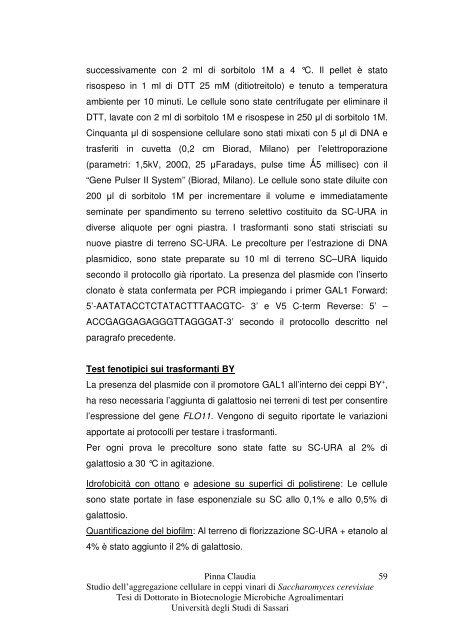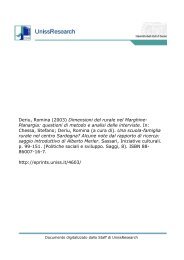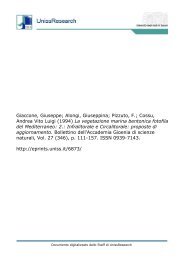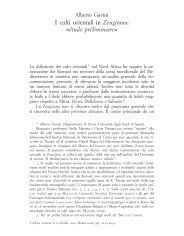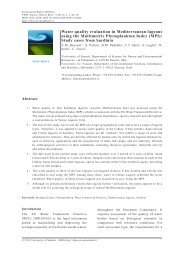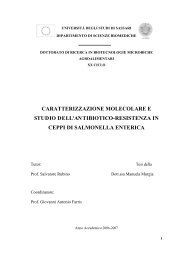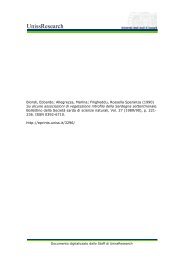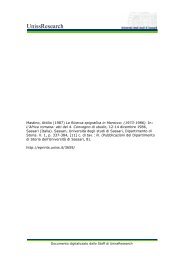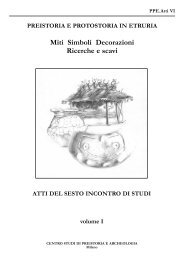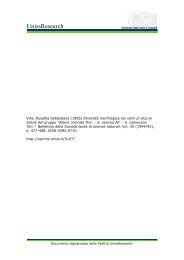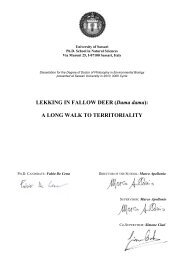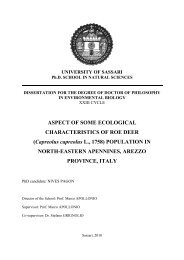Studio dell'aggregazione cellulare in ceppi vinari di Saccharomyces ...
Studio dell'aggregazione cellulare in ceppi vinari di Saccharomyces ...
Studio dell'aggregazione cellulare in ceppi vinari di Saccharomyces ...
Create successful ePaper yourself
Turn your PDF publications into a flip-book with our unique Google optimized e-Paper software.
successivamente con 2 ml <strong>di</strong> sorbitolo 1M a 4 °C. Il pellet è stato<br />
risospeso <strong>in</strong> 1 ml <strong>di</strong> DTT 25 mM (<strong>di</strong>tiotreitolo) e tenuto a temperatura<br />
ambiente per 10 m<strong>in</strong>uti. Le cellule sono state centrifugate per elim<strong>in</strong>are il<br />
DTT, lavate con 2 ml <strong>di</strong> sorbitolo 1M e risospese <strong>in</strong> 250 µl <strong>di</strong> sorbitolo 1M.<br />
C<strong>in</strong>quanta µl <strong>di</strong> sospensione <strong>cellulare</strong> sono stati mixati con 5 µl <strong>di</strong> DNA e<br />
trasferiti <strong>in</strong> cuvetta (0,2 cm Biorad, Milano) per l’elettroporazione<br />
(parametri: 1,5kV, 200Ω, 25 µFaradays, pulse time Ǻ5 millisec) con il<br />
“Gene Pulser II System” (Biorad, Milano). Le cellule sono state <strong>di</strong>luite con<br />
200 µl <strong>di</strong> sorbitolo 1M per <strong>in</strong>crementare il volume e imme<strong>di</strong>atamente<br />
sem<strong>in</strong>ate per span<strong>di</strong>mento su terreno selettivo costituito da SC-URA <strong>in</strong><br />
<strong>di</strong>verse aliquote per ogni piastra. I trasformanti sono stati strisciati su<br />
nuove piastre <strong>di</strong> terreno SC-URA. Le precolture per l’estrazione <strong>di</strong> DNA<br />
plasmi<strong>di</strong>co, sono state preparate su 10 ml <strong>di</strong> terreno SC–URA liquido<br />
secondo il protocollo già riportato. La presenza del plasmide con l’<strong>in</strong>serto<br />
clonato è stata confermata per PCR impiegando i primer GAL1 Forward:<br />
5’-AATATACCTCTATACTTTAACGTC- 3’ e V5 C-term Reverse: 5’ –<br />
ACCGAGGAGAGGGTTAGGGAT-3’ secondo il protocollo descritto nel<br />
paragrafo precedente.<br />
Test fenotipici sui trasformanti BY<br />
La presenza del plasmide con il promotore GAL1 all’<strong>in</strong>terno dei <strong>ceppi</strong> BY + ,<br />
ha reso necessaria l’aggiunta <strong>di</strong> galattosio nei terreni <strong>di</strong> test per consentire<br />
l’espressione del gene FLO11. Vengono <strong>di</strong> seguito riportate le variazioni<br />
apportate ai protocolli per testare i trasformanti.<br />
Per ogni prova le precolture sono state fatte su SC-URA al 2% <strong>di</strong><br />
galattosio a 30 °C <strong>in</strong> agitazione.<br />
Idrofobicità con ottano e adesione su superfici <strong>di</strong> polistirene: Le cellule<br />
sono state portate <strong>in</strong> fase esponenziale su SC allo 0,1% e allo 0,5% <strong>di</strong><br />
galattosio.<br />
Quantificazione del biofilm: Al terreno <strong>di</strong> florizzazione SC-URA + etanolo al<br />
4% è stato aggiunto il 2% <strong>di</strong> galattosio.<br />
P<strong>in</strong>na Clau<strong>di</strong>a<br />
<strong>Stu<strong>di</strong>o</strong> dell’aggregazione <strong>cellulare</strong> <strong>in</strong> <strong>ceppi</strong> v<strong>in</strong>ari <strong>di</strong> <strong>Saccharomyces</strong> cerevisiae<br />
Tesi <strong>di</strong> Dottorato <strong>in</strong> Biotecnologie Microbiche Agroalimentari<br />
Università degli Stu<strong>di</strong> <strong>di</strong> Sassari<br />
59


